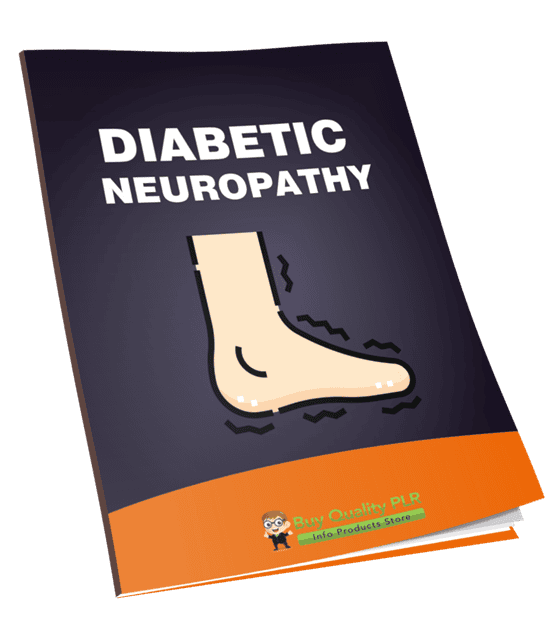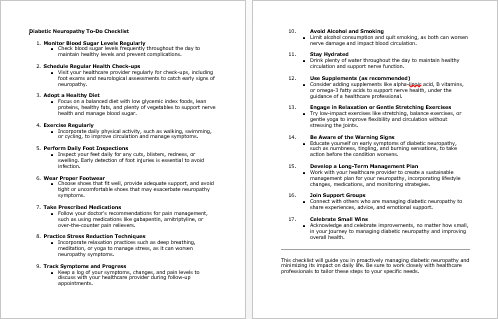
Diabetic Neuropathy PLR Course 26k Words
in Diabetes PLR , Diabetes PLR Ebooks , Health Ebooks MRR , Health PLR , MRR eBooks , Pain PLR , Pain PLR Ebooks , PLR Checklists , PLR eBooks , PLR eCourses , PLR List Building Reports , Premium PLR , Premium PLR eBooks , Premium PLR Reports , Premium White Label Brandable PLR Coaching Courses , Private Label Rights ProductsChoose Your Desired Option(s)
has been added to your cart!
have been added to your cart!
#diabeticneuropathy #neuropathyrelief #diabetescare #plrcourse #healthplr #wellnesscontent #privatelabelrights #resellablecourse #diabeteseducation #chronicpainrelief
Diabetic Neuropathy PLR Course: A Comprehensive Guide to Understanding, Managing, and Preventing Nerve Damage from Diabetes
Are you ready to make a real impact on your audience by offering them a comprehensive, step-by-step guide to understanding, managing, and preventing diabetic neuropathy? Presenting the Diabetic Neuropathy PLR Course—a 24,111-word course designed to provide valuable education on nerve damage caused by diabetes. This course will help your customers take control of their health by offering practical steps for managing symptoms, preventing further damage, and improving quality of life.
Whether you want to sell the course as a digital product, incorporate it into your wellness programs, or create a membership site, the Diabetic Neuropathy PLR Course offers immense potential to monetize and grow your business. Let’s explore how you can use this course to help your audience and profit from it.
Presenting…
Diabetic Neuropathy PLR Course 26k Words
Course Overview: What’s Inside the Diabetic Neuropathy PLR Course?
This PLR course is structured to provide clear, actionable guidance for anyone dealing with diabetic neuropathy. From understanding the condition to daily management, this course is the ultimate resource for managing nerve damage associated with diabetes. Here’s what’s inside:
Module 1: Understanding Diabetic Neuropathy
Before jumping into treatment and management, it’s crucial to understand what diabetic neuropathy is and how it develops.
- Step 1: What is Diabetic Neuropathy?
- Step 2: Types of Diabetic Neuropathy
- Step 3: Symptoms to Watch For
- Step 4: Why Does It Happen? (The Science Behind It)
Module 2: Diagnosis & Medical Management
Once the basics are understood, it’s time to explore how neuropathy is diagnosed and managed medically.
- Step 1: How Doctors Diagnose It
- Step 2: Medications for Neuropathy Pain
- Step 3: Lifestyle Changes & Blood Sugar Control
- Step 4: Alternative & Holistic Treatments
Module 3: Everyday Management & Pain Relief
This module covers practical, everyday management techniques for improving nerve health and reducing pain.
- Step 1: Foot Care 101 – Protecting Your Feet
- Step 2: Exercises for Nerve Health
- Step 3: Nutrition & Supplements for Nerve Health
- Step 4: Stress & Sleep – The Hidden Factors
Module 4: Preventing Further Nerve Damage
Preventing additional nerve damage is essential for managing diabetic neuropathy in the long run.
- Step 1: Blood Sugar Control Strategies
- Step 2: Avoiding Common Triggers
- Step 3: Monitoring & Early Warning Signs
- Step 4: Building a Long-Term Management Plan
Module 5: Living Well with Diabetic Neuropathy
This final module helps your audience thrive despite the challenges of diabetic neuropathy by embracing a positive mindset and lifestyle changes.
- Step 1: Mindset & Mental Health
- Step 2: Support Systems – You’re Not Alone!
- Step 3: Adapting Daily Activities for Comfort
- Step 4: Celebrating Progress & Small Wins
Bonus Materials to Enhance the Course
We’ve included some valuable bonus materials to increase the value of the course and help you better serve your customers:
- Diabetic Neuropathy – Checklist (460 words): A concise checklist that helps individuals stay on track with their neuropathy management.
- Diabetic Neuropathy – FAQs (944 words): A detailed FAQ section answering common questions about diabetic neuropathy.
- Diabetic Neuropathy – Salespage (850 words): A professionally written sales page that you can use to promote and sell the course.
How to Profit from the Diabetic Neuropathy PLR Course
The Diabetic Neuropathy PLR Course offers various ways to profit, making it a versatile asset for your business. Here are a few ideas for how you can monetize the content:
1. Sell the Course as a Standalone Product
You can sell this PLR course directly on your website, through third-party platforms like Udemy or Teachable, or via social media channels for $47–$97, depending on the added value and your target market.
2. Break the Course Into Smaller Reports
Excerpt sections of the course into smaller, digestible reports or mini-courses and sell them for $10–$20 each. This allows you to provide value at a lower price point, attracting more customers.
3. Bundle with Other Related Content
Bundle the PLR course with other wellness, health, or diabetes-related products to create a premium package. Sell the bundle for $97–$197 for greater profit potential.
4. Set Up a Membership Site
You can set up a membership site where subscribers pay a recurring fee to access the full course, as well as bonus content like ongoing support, additional articles, and webinars. This model generates steady, passive income.
5. Convert Into a Video or Audio Series
Repurpose the PLR course into video lessons or an audio series, and sell them for a higher price. Video and audio formats are appealing to different learning styles and can increase engagement.
6. Use as a Lead Magnet
Offer parts of the course as free content in exchange for email sign-ups, growing your email list. Once you have an engaged audience, you can upsell them to the full course or other related products.
7. Create a Physical Product
Turn the content from the PLR course into a physical guidebook or workbook. This option allows you to sell the course in a more tangible form, attracting customers who prefer physical products.
What You Can Do with This PLR Course
Permissions – What Can You Do With These Materials?
- Sell the content with minor tweaks to make it your own.
- Break the content into smaller reports to sell for $10-$20 each.
- Bundle it with other wellness-related products for $47-$97.
- Set up a membership site and charge recurring fees.
- Convert the course into video lessons, audio series, or even a physical book.
- Use portions of the content as lead magnets to build your email list.
- Repurpose the course content for social media posts, webinars, or eBooks.
Restrictions – What Can’t You Do With These Materials?
- You cannot pass on PLR rights to your customers.
- You cannot offer 100% affiliate commissions.
- You cannot give away the complete course for free in its current state. You must sell it or excerpt/modify portions for giveaways.
- You cannot add the course to existing customer orders without requiring an additional purchase.
Start Empowering Your Audience with the Diabetic Neuropathy PLR Course Today!
The Diabetic Neuropathy PLR Course is the perfect solution for anyone in the health and wellness industry looking to provide valuable content to individuals struggling with neuropathy due to diabetes. With comprehensive content, actionable advice, and multiple ways to profit, this course is a must-have for anyone in the diabetes care or wellness niche.
Take control of your business and help others take control of their health! Purchase the Diabetic Neuropathy PLR Course today and start profiting.
has been added to your cart!
have been added to your cart!
Here A Sample of Diabetic Neuropathy PLR Course
A Step-by-Step Guide to Understanding, Managing, and Preventing Nerve Damage from Diabetes
Module 1: Understanding Diabetic Neuropathy
Step 1: What is Diabetic Neuropathy?
Introduction to Diabetic Neuropathy
Diabetic neuropathy is one of the most common complications of diabetes, affecting millions of people worldwide. It refers to nerve damage caused by prolonged high blood sugar levels, which can lead to symptoms such as numbness, tingling, pain, and weakness—primarily in the hands and feet.
This condition can significantly impact a person’s quality of life, mobility, and long-term health. Without proper management, it can lead to severe complications, including foot ulcers, infections, and even amputations. That is why early detection and proactive treatment are essential.
In this step, we will explore:
- The definition of diabetic neuropathy
- The process of nerve damage caused by diabetes
- The importance of addressing it early
By the end of this section, you will have a clear understanding of what diabetic neuropathy is and why it requires immediate attention.
1. Understanding the Basics of Diabetic Neuropathy
What is Neuropathy?
The term neuropathy refers to nerve damage or dysfunction. In the case of diabetic neuropathy, high blood sugar levels over time cause damage to the nerves, leading to symptoms such as pain, numbness, and weakness.
Diabetic neuropathy primarily affects the peripheral nervous system (PNS), which includes the nerves outside of the brain and spinal cord. These nerves are responsible for:
- Sensation (touch, pain, temperature)
- Movement (muscle coordination and reflexes)
- Autonomic functions (digestion, blood pressure regulation, sweating)
When these nerves are damaged, the body’s ability to send and receive signals correctly is disrupted, leading to a range of symptoms.
Why is it Called ‘Diabetic’ Neuropathy?
Diabetic neuropathy is specifically linked to chronic high blood glucose levels in individuals with Type 1 or Type 2 diabetes. Over time, excessive glucose in the bloodstream can cause:
- Oxidative stress – damaging nerve cells
- Inflammation – contributing to nerve degeneration
- Poor circulation – reducing oxygen and nutrient delivery to nerves
These factors combine to create a condition where nerves slowly deteriorate and lose function.
2. How Does Diabetic Neuropathy Develop?
Diabetic neuropathy does not happen overnight; it is a gradual process that occurs over months or years. Here’s how nerve damage progresses:
Step 1: High Blood Sugar Levels (Hyperglycemia)
- When blood sugar remains too high for too long, it begins to damage small blood vessels (capillaries) that supply oxygen and nutrients to the nerves.
- Without proper nourishment, nerve cells begin to malfunction and degenerate.
Step 2: Damage to the Nerve Fibers
- Nerve fibers rely on a delicate balance of electrical and chemical signals to function.
- High blood sugar disrupts this balance, leading to nerve inflammation, swelling, and dysfunction.
Step 3: Gradual Loss of Sensation and Function
- As nerve damage progresses, the ability to feel pain, temperature, and touch begins to diminish.
- In some cases, patients experience severe pain, while others may feel nothing at all—even when injured.
- If left untreated, this can lead to serious complications such as foot ulcers and infections.
3. Why is it Important to Address Diabetic Neuropathy Early?
Preventing Further Nerve Damage
Once nerve damage occurs, it cannot be fully reversed. However, early intervention can slow down the progression and prevent severe complications.
Reducing the Risk of Complications
Severe neuropathy can lead to loss of mobility, foot infections, and amputations. Managing it early can help maintain an active and independent lifestyle.
Improving Quality of Life
Neuropathy symptoms, such as chronic pain and numbness, can interfere with daily activities, sleep, and overall well-being. Addressing it early ensures a better quality of life.
Enhancing Blood Sugar Control
Managing diabetic neuropathy encourages better blood sugar control, which benefits overall health and prevents additional complications related to diabetes, such as heart disease and kidney damage.
Key Takeaways from This Lesson
- Diabetic neuropathy is a type of nerve damage caused by high blood sugar levels.
- It primarily affects the peripheral nervous system, leading to numbness, tingling, pain, and loss of sensation.
- The condition develops gradually and can lead to severe complications if left untreated.
- Early diagnosis and proactive management are essential to slowing down nerve damage and improving quality of life.
What’s Next?
Now that you understand what diabetic neuropathy is and why it’s important to address it early, the next step is to explore the different types of diabetic neuropathy and how they affect the body.
In the next lesson, we will break down:
✔ The four main types of diabetic neuropathy
✔ The specific symptoms of each type
✔ How different types impact daily life
Let’s continue learning and take control of diabetic neuropathy!
Step 2: Types of Diabetic Neuropathy
Introduction to the Different Types of Diabetic Neuropathy
Diabetic neuropathy is not a one-size-fits-all condition. It affects different people in different ways, depending on which nerves are damaged. Understanding the four main types of diabetic neuropathy—peripheral, autonomic, proximal, and focal neuropathy—is crucial for recognizing symptoms and managing the condition effectively.
Each type targets a specific area of the nervous system, leading to unique symptoms and complications. Some people may experience only one type, while others may suffer from multiple forms at the same time.
In this step, we will break down:
- Peripheral Neuropathy – The most common type, affecting the feet and hands.
- Autonomic Neuropathy – Impacting involuntary functions like digestion and heart rate.
- Proximal Neuropathy – Causing weakness and pain in the hips, thighs, and buttocks.
- Focal Neuropathy – Sudden nerve damage affecting specific nerves or areas.
By the end of this lesson, you will have a clear understanding of how each type of diabetic neuropathy affects the body and what symptoms to watch for.
1. Peripheral Neuropathy (Most Common Type)
What is Peripheral Neuropathy?
Peripheral neuropathy is the most widespread form of diabetic neuropathy, affecting about 50% of people with diabetes. It primarily damages the peripheral nerves, which are responsible for sending signals between the brain, spinal cord, and the rest of the body.
Which Areas Are Affected?
- Feet and legs (most common)
- Hands and arms (less common)
Symptoms of Peripheral Neuropathy
Symptoms usually begin in the toes and feet before spreading upward to the legs, and then to the hands and arms. They include:
✔ Numbness or loss of sensation in the affected areas
✔ Tingling, burning, or sharp pain (especially at night)
✔ Muscle weakness and loss of balance
✔ Increased sensitivity to touch (even a bedsheet may feel painful)
✔ Wounds or ulcers on the feet due to lack of sensation
Why is Peripheral Neuropathy Dangerous?
Many people with peripheral neuropathy develop foot problems due to lack of feeling. Cuts, blisters, or sores can go unnoticed and become infected, increasing the risk of amputation if untreated.
What to Do?
✔ Daily foot checks to detect injuries early
✔ Wearing comfortable shoes to avoid pressure points
✔ Controlling blood sugar levels to slow nerve damage
2. Autonomic Neuropathy (Affects Involuntary Functions)
What is Autonomic Neuropathy?
Autonomic neuropathy affects the autonomic nervous system, which controls automatic body functions like digestion, heart rate, blood pressure, and sweating. Since these functions happen without conscious effort, damage to these nerves can cause serious health issues.
Which Areas Are Affected?
- Digestive system (stomach, intestines)
- Heart and blood vessels
- Bladder and sexual organs
- Sweat glands
Symptoms of Autonomic Neuropathy
✔ Digestive Issues – Bloating, nausea, constipation, or diarrhea (gastroparesis)
✔ Heart Problems – Fast or irregular heart rate, dizziness when standing (low blood pressure)
✔ Bladder Issues – Frequent infections, difficulty emptying the bladder
✔ Sexual Dysfunction – Erectile dysfunction in men, vaginal dryness in women
✔ Sweating Problems – Excessive sweating or inability to sweat
Why is Autonomic Neuropathy Dangerous?
- People with heart-related autonomic neuropathy may not feel typical warning signs of a heart attack (such as chest pain).
- Gastroparesis slows digestion, making it difficult to control blood sugar levels.
- Urinary issues can lead to infections and kidney problems.
What to Do?
✔ Monitor heart rate and blood pressure regularly
✔ Eat smaller meals to manage digestion issues
✔ Stay hydrated and practice bladder training techniques
3. Proximal Neuropathy (Affects the Hips, Thighs, and Buttocks)
What is Proximal Neuropathy?
Proximal neuropathy is a rare but debilitating type of diabetic neuropathy that affects the large nerves in the thighs, hips, buttocks, and legs. It is more common in older adults with Type 2 diabetes.
Which Areas Are Affected?
- Hips and buttocks
- Thighs and legs
- Lower back
Symptoms of Proximal Neuropathy
✔ Severe pain in one side of the hip, thigh, or buttock
✔ Muscle weakness in the legs, making it difficult to stand up
✔ Weight loss due to muscle wasting
✔ Sudden onset of pain, followed by slow recovery over months
Why is Proximal Neuropathy Dangerous?
- It can limit mobility, making everyday activities like walking, climbing stairs, or getting up from a chair extremely difficult.
- It can lead to long-term muscle weakness and disability if left untreated.
What to Do?
✔ Physical therapy to regain muscle strength
✔ Pain management strategies, including medications and stretching exercises
✔ Proper nutrition to support muscle recovery
4. Focal Neuropathy (Sudden Nerve Damage in Specific Areas)
What is Focal Neuropathy?
Focal neuropathy refers to sudden, isolated nerve damage in a specific area of the body. It often occurs unexpectedly and resolves on its own within weeks or months.
Which Areas Are Affected?
- Head and face (including the eyes)
- Torso and abdomen
- Hands, legs, and feet
Symptoms of Focal Neuropathy
✔ Sudden, intense pain in the affected area
✔ Double vision or eye pain due to nerve damage in the eye muscles
✔ Paralysis of one side of the face (Bell’s palsy)
✔ Nerve pain in the chest or abdomen, sometimes mistaken for a heart attack
Why is Focal Neuropathy Dangerous?
- It can cause temporary loss of function in crucial areas like the eyes or hands.
- If affecting the chest, it may mimic symptoms of a heart attack, leading to misdiagnosis.
What to Do?
✔ Seek medical attention immediately if symptoms appear suddenly
✔ Use pain management techniques prescribed by a doctor
✔ Monitor for improvement, as focal neuropathy often resolves on its own
Key Takeaways from This Lesson
- Diabetic neuropathy comes in four main types, each affecting different parts of the body.
- Peripheral neuropathy affects the feet and hands, leading to pain and numbness.
- Autonomic neuropathy impacts internal organs, leading to digestive, heart, and bladder problems.
- Proximal neuropathy causes pain and muscle weakness in the hips, thighs, and legs.
- Focal neuropathy is sudden nerve damage that affects specific areas, like the eyes or chest.
- Early detection and management are crucial to preventing complications.
What’s Next?
Now that you understand the different types of diabetic neuropathy, the next step is to learn about how to diagnose and detect neuropathy early.
In the next lesson, we will cover:
✔ The tests used to diagnose diabetic neuropathy
✔ How doctors measure nerve function
✔ What symptoms require immediate medical attention
Let’s move forward and take control of diabetic neuropathy together!
Step 3: Symptoms to Watch For
Recognizing the Warning Signs of Diabetic Neuropathy
Diabetic neuropathy does not appear overnight. It progresses gradually, and in many cases, the early symptoms can be so mild that they go unnoticed. However, recognizing the warning signs early is crucial for preventing further nerve damage and avoiding serious complications.
Some people may experience mild numbness, while others may suffer from severe pain, weakness, or even organ dysfunction. The symptoms you experience depend on which type of neuropathy you have and which nerves are affected.
In this step, we will break down:
✔ Common symptoms that affect most people with diabetic neuropathy
✔ Not-so-common symptoms that are easy to overlook
✔ How symptoms progress over time
✔ When to seek medical attention
By the end of this lesson, you will have a clear understanding of what to watch for and when to take action.
1. Common Symptoms of Diabetic Neuropathy
1.1 Numbness and Tingling in the Feet or Hands
One of the earliest signs of diabetic neuropathy is a gradual loss of sensation in the feet, legs, hands, or arms. This can feel like:
✔ A “pins and needles” sensation
✔ A buzzing or vibrating feeling in the feet
✔ A feeling of wearing invisible socks or gloves
People often ignore this symptom because it is painless, but it is actually a red flag that nerves are losing function. Over time, this numbness can lead to serious injuries because you may not feel cuts, burns, or infections.
1.2 Burning, Sharp, or Stabbing Pain
As neuropathy progresses, damaged nerves may misfire, sending incorrect pain signals to the brain. This can result in:
✔ Burning pain (feeling like your skin is on fire)
✔ Sharp, stabbing pain (as if being pricked by needles)
✔ Electric shock-like sensations
This pain is often worse at night and can disrupt sleep, leading to fatigue, stress, and reduced quality of life.
1.3 Muscle Weakness and Loss of Coordination
Diabetic neuropathy can damage the nerves that control muscle movement, leading to:
✔ Leg and foot weakness (difficulty walking or climbing stairs)
✔ Loss of balance (frequent tripping or falling)
✔ Muscle shrinkage (atrophy)
If left untreated, this can make simple tasks like standing up, gripping objects, or walking much harder.
2. Not-So-Common Symptoms (Often Overlooked)
2.1 Extreme Sensitivity to Touch
Some people with diabetic neuropathy experience allodynia, a condition where even the lightest touch causes pain. This can mean:
✔ Bed sheets or socks feel painful
✔ A light breeze on the skin triggers discomfort
This unusual symptom is a sign that sensory nerves are misfiring, interpreting normal stimuli as pain.
2.2 Foot Ulcers and Slow-Healing Wounds
Because neuropathy causes numbness, injuries may go unnoticed. People with diabetic neuropathy often develop foot ulcers due to:
✔ Unnoticed cuts or blisters
✔ Pressure from tight shoes
✔ Poor circulation leading to slow healing
If an ulcer becomes infected, it can lead to serious complications, including amputation.
2.3 Digestive Problems (Autonomic Neuropathy Symptom)
When diabetes affects the autonomic nervous system, it can slow digestion, leading to:
✔ Bloating and nausea after eating
✔ Constipation or diarrhea
✔ Unpredictable blood sugar swings due to delayed stomach emptying (gastroparesis)
2.4 Dizziness and Fainting (Blood Pressure Issues)
Nerve damage can affect how the body regulates blood pressure, leading to orthostatic hypotension—a condition where blood pressure drops suddenly when standing up. This can cause:
✔ Dizziness or lightheadedness
✔ Fainting spells
✔ Weakness when changing positions
2.5 Vision Problems and Facial Nerve Weakness
Focal neuropathy can affect specific nerves in the face or eyes, causing:
✔ Blurred or double vision
✔ Eyelid drooping
✔ Facial paralysis (Bell’s palsy-like symptoms)
These symptoms may appear suddenly but often resolve on their own in a few weeks or months.
3. How Symptoms Progress Over Time
Early Stage (Mild Symptoms – Easily Overlooked)
- Occasional tingling in the feet
- Mild burning pain at night
- Slight balance issues
- Increased sensitivity to touch
Moderate Stage (More Noticeable Symptoms)
- Persistent numbness and weakness in feet and hands
- Sharp, shooting pains in legs or arms
- Foot deformities due to muscle weakness
- Difficulty standing or walking
Severe Stage (High Risk for Complications)
- Complete loss of sensation in feet (inability to feel pain or temperature)
- Foot ulcers or infections that don’t heal
- Severe muscle atrophy (weakness or inability to move muscles)
- Loss of bladder or bowel control
- Heart rhythm issues and extreme dizziness
At the severe stage, untreated neuropathy can lead to disability, hospitalization, or life-threatening complications.
4. When to Seek Medical Attention
Early intervention can slow or even prevent worsening nerve damage. Seek medical help if you experience:
✔ Numbness or tingling that doesn’t go away
✔ Pain in your feet, legs, or hands—especially at night
✔ Weakness, trouble walking, or frequent falls
✔ Sudden vision problems or facial muscle weakness
✔ Slow-healing sores or infections on the feet
✔ Severe digestive issues or unexplained blood pressure drops
If left untreated, diabetic neuropathy can become irreversible, so early detection is key.
Key Takeaways from This Lesson
- Diabetic neuropathy symptoms vary based on which nerves are affected.
- Common symptoms include numbness, tingling, burning pain, and muscle weakness.
- Less common symptoms include foot ulcers, digestive issues, dizziness, and vision problems.
- Symptoms worsen over time if diabetes is not well-controlled.
- Seeking medical attention early can prevent serious complications.
What’s Next?
Now that you can recognize the symptoms of diabetic neuropathy, it’s time to learn how doctors diagnose the condition.
In the next lesson, we will cover:
✔ The tests used to confirm diabetic neuropathy
✔ How doctors measure nerve function
✔ What symptoms require urgent medical attention
Let’s move forward and learn how neuropathy is diagnosed and monitored!
Step 4: Why Does It Happen? (The Science Behind It)
Understanding the Science of Diabetic Neuropathy
Diabetic neuropathy doesn’t happen overnight. It develops gradually over time as high blood sugar levels damage the nerves. But how exactly does this happen? What is going on inside the body that leads to numbness, pain, or muscle weakness?
In this lesson, we will break it down step by step so you can understand the science without getting overwhelmed.
By the end of this step, you will learn:
✔ How high blood sugar affects nerve function
✔ Why certain nerves are more vulnerable to damage
✔ The role of blood circulation and inflammation in nerve damage
✔ Why managing blood sugar is the key to preventing neuropathy
Let’s dive in!
1. How High Blood Sugar Affects Nerves
Your nerves act like electrical wires, carrying signals from the brain to the rest of the body. These signals control everything from muscle movement and sensation to digestion and heart rate.
For nerves to function properly, they need:
✔ A steady supply of oxygen and nutrients
✔ Protective insulation (myelin sheath) to conduct signals efficiently
✔ A healthy environment free from toxins and inflammation
But when blood sugar levels remain too high for too long, it disrupts these essential conditions.
1.1 Sugar Overload: The Start of Nerve Damage
When glucose (sugar) levels stay too high in the bloodstream, excess sugar:
✔ Attaches to proteins and fats, forming harmful compounds called Advanced Glycation End-products (AGEs).
✔ Creates oxidative stress, which damages nerve cells.
✔ Triggers chronic inflammation, making it harder for nerves to repair themselves.
Think of it like this: Imagine pouring sticky syrup over an electrical wire. Over time, the wire becomes coated and clogged, slowing down signals and eventually stopping them altogether. This is what happens to nerves affected by diabetic neuropathy.
2. Why Are Nerves So Vulnerable?
Not all parts of the body are affected by diabetes in the same way. Some nerves are especially vulnerable to damage. But why?
2.1 Nerves Have No Backup Energy Source
Unlike muscles or other organs, nerves don’t store energy. They depend entirely on a continuous supply of glucose and oxygen from the blood. When blood sugar levels fluctuate wildly, nerves struggle to function properly and eventually die off.
2.2 The Longest Nerves Are Hit the Hardest
The nerves that extend the farthest—like those in the feet, legs, and hands—are usually the first to be damaged. These nerves require more energy and blood flow than shorter nerves. If they don’t receive enough nutrients, they become weak, leading to numbness, tingling, and pain.
This is why diabetic neuropathy often starts in the feet and spreads upwards.
2.3 Nerve Coating (Myelin Sheath) Breaks Down
Healthy nerves are protected by a fatty layer called the myelin sheath, which helps signals travel smoothly. High blood sugar damages this protective layer, causing:
✔ Slower nerve communication (delayed reflexes and muscle weakness)
✔ Misinformation to the brain (burning pain, even when nothing is wrong)
✔ Loss of sensation (numbness in the feet or hands)
As the myelin sheath deteriorates, nerve function declines further, making symptoms worse over time.
3. The Role of Blood Circulation and Inflammation
Diabetes doesn’t just harm the nerves—it also damages the small blood vessels that supply them with oxygen and nutrients.
3.1 Poor Circulation Cuts Off Nutrients
High blood sugar damages capillaries (tiny blood vessels), reducing blood flow to the nerves.
✔ Nerves become starved of oxygen, causing them to shrink and die.
✔ The body loses its ability to repair damaged nerves.
✔ Wounds and infections take longer to heal, increasing the risk of ulcers and amputations.
Think of it like watering a plant. If the roots don’t get enough water, the plant starts to wilt and die. The same thing happens to nerves when blood flow is restricted.
3.2 Chronic Inflammation Triggers More Damage
Diabetes increases inflammation throughout the body, which causes:
✔ Swelling and pressure on nerves, leading to pain.
✔ An immune system overreaction, which mistakenly attacks nerve tissue.
✔ A cycle of ongoing damage, making it harder for nerves to heal.
This combination of poor circulation and chronic inflammation is what makes diabetic neuropathy progress faster if not managed properly.
4. Why Blood Sugar Management Is Key
Now that we understand how high blood sugar damages nerves, the next question is: How can we stop it?
The good news is that neuropathy can be slowed down—or even prevented—by keeping blood sugar levels in a healthy range.
4.1 Controlling Blood Sugar to Protect Nerves
When blood sugar is kept within a normal range, the risk of nerve damage is greatly reduced.
✔ Fewer harmful sugar deposits build up in the nerves.
✔ Less oxidative stress means nerves can heal faster.
✔ Blood circulation improves, keeping nerves well-nourished.
Studies show that people who maintain good blood sugar control reduce their risk of neuropathy by up to 60%.
4.2 Lifestyle Changes That Help
To protect nerves and prevent neuropathy, it’s important to:
✔ Monitor blood sugar regularly (keep it stable, avoiding spikes).
✔ Eat a balanced diet (low in processed sugars and high in fiber).
✔ Exercise regularly (improves circulation and lowers blood sugar).
✔ Quit smoking and limit alcohol (both worsen nerve damage).
✔ Manage stress and sleep well (reduces inflammation in the body).
These changes not only help prevent neuropathy but also improve overall health and quality of life.
Key Takeaways from This Lesson
- Diabetic neuropathy happens because high blood sugar damages nerves over time.
- Excess sugar leads to oxidative stress, inflammation, and nerve degeneration.
- Nerves are highly vulnerable because they lack backup energy and rely on good circulation.
- Poor blood flow and chronic inflammation make neuropathy worse.
- Keeping blood sugar under control is the most effective way to prevent nerve damage.
What’s Next?
Now that you understand why diabetic neuropathy happens, the next step is learning how to manage it effectively.
In the next lesson, we will cover:
✔ Treatment options for diabetic neuropathy
✔ Medications, therapies, and lifestyle adjustments
✔ How to relieve symptoms and prevent complications
Let’s move forward and explore how to take control of neuropathy!
We’re also giving these extra bonuses
Diabetic Neuropathy – Checklist
Diabetic Neuropathy – FAQs

Diabetic Neuropathy – Salespage Content

Package Details:
Word Count: 24 111 Words
Number of Pages: 101
Diabetic Neuropathy – Bonus Content
Checklist
Word Count: 460 words
FAQs
Word Count: 944 words
Salespage Content
Word Count: 850 words
Total Word Count: 26 365 Words
Your PLR License Terms
PERMISSIONS: What Can You Do With These Materials?
Sell the content basically as it is (with some minor tweaks to make it “yours”).
If you are going to claim copyright to anything created with this content, then you must substantially change at 75% of the content to distinguish yourself from other licensees.
Break up the content into small portions to sell as individual reports for $10-$20 each.
Bundle the content with other existing content to create larger products for $47-$97 each.
Setup your own membership site with the content and generate monthly residual payments!
Take the content and convert it into a multiple-week “eclass” that you charge $297-$497 to access!
Use the content to create a “physical” product that you sell for premium prices!
Convert it to audios, videos, membership site content and more.
Excerpt and / or edit portions of the content to give away for free as blog posts, reports, etc. to use as lead magnets, incentives and more!
Create your own original product from it, set it up at a site and “flip” the site for megabucks!
RESTRICTIONS: What Can’t You Do With These Materials?
To protect the value of these products, you may not pass on the rights to your customers. This means that your customers may not have PLR rights or reprint / resell rights passed on to them.
You may not pass on any kind of licensing (PLR, reprint / resell, etc.) to ANY offer created from ANY PORTION OF this content that would allow additional people to sell or give away any portion of the content contained in this package.
You may not offer 100% commission to affiliates selling your version / copy of this product. The maximum affiliate commission you may pay out for offers created that include parts of this content is 75%.
You are not permitted to give the complete materials away in their current state for free – they must be sold. They must be excerpted and / or edited to be given away, unless otherwise noted. Example: You ARE permitted to excerpt portions of content for blog posts, lead magnets, etc.
You may not add this content to any part of an existing customer order that would not require them to make an additional purchase. (IE You cannot add it to a package, membership site, etc. that customers have ALREADY paid for.)
Share Now!













